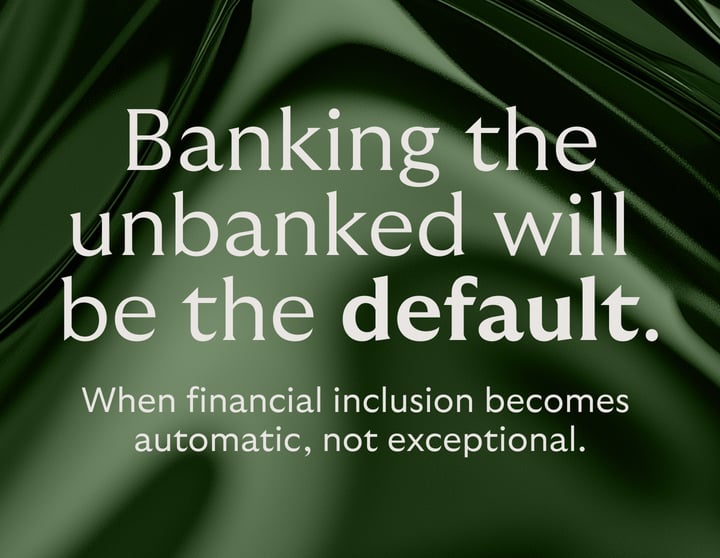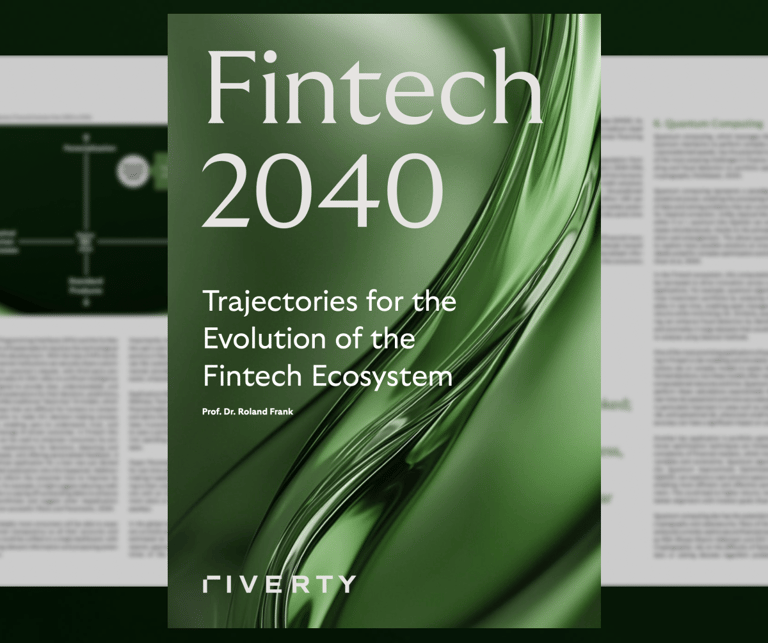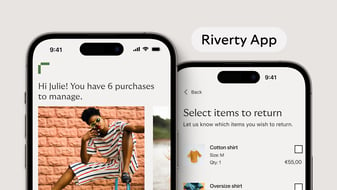Banking the unbanked will be the default
Over 1.4 billion adults globally are still unbanked – without access to secure, regulated financial services. This financial exclusion creates a massive barrier to economic participation, limiting opportunities for billions of people worldwide.
But banking the unbanked is no longer a question of if, but when. The rapid rise of mobile banking, embedded finance, and fintech innovation is shifting the landscape, creating the infrastructure and momentum to make banking the unbanked the global default by 2040.

The global scale of financial exclusion
Who are the unbanked? They span regions, genders, and income levels, but share common barriers: lack of documentation, distance from financial institutions, limited digital access, and broken trust in traditional banking systems. Financial exclusion doesn’t just limit individual opportunity – it constrains economic development, blocks access to credit, restricts social mobility, and undermines long-term stability for entire communities.
In 2025, roughly 1.4 billion people still lack formal banking access. However, progress is accelerating rapidly. Indonesia increased its banked population from 49% in 2014 to 83% in 2023, largely through fintech growth. This transformation demonstrates how digital innovation can rapidly bridge the inclusion gap where traditional banking has failed.
Digital disruption: A turning point for banking the unbanked
Mobile phones and internet penetration are creating unprecedented opportunities for banking the unbanked. The convergence of mobile banking, digital wallets, and embedded finance is enabling financial services to reach previously excluded populations at scale.
Regulatory innovation drives access
Regulatory innovation is equally crucial for banking the unbanked success. E-KYC processes, open banking frameworks, and supportive fintech regulations are dismantling traditional barriers to financial access. These developments enable financial institutions to serve customers who were previously “unscorable” using mobile payment histories, alternative data sources, and AI-driven risk assessment.
From specialized to embedded
Banking the unbanked is becoming embedded in everyday platforms rather than requiring separate financial destinations. When financial services integrate seamlessly into e-commerce, healthcare, and mobility platforms, inclusion becomes automatic rather than exceptional. This shift represents banking the unbanked evolving from a specialized initiative to a default expectation.
Success stories: Banking the unbanked in practice
Case Study: Indonesia’s digital transformation
Indonesia’s remarkable journey demonstrates how banking the unbanked can become reality at scale. The country increased its banked population from 49% in 2014 to 83% in 2023, largely through fintech growth and mobile-first financial services. This transformation shows that when banking the unbanked is prioritized through technology and regulatory support, entire nations can achieve financial inclusion within a decade.
AI-powered risk assessment
Technology enables banking the unbanked by assessing previously “unscorable” consumers using mobile payment histories, social data, and other non-traditional indicators. Automated processes drive down service costs, enabling banks and fintechs to offer no-fee accounts and small loans profitably.
Real-world implementation
A concrete example: a rural entrepreneur can now open an account through their phone within minutes, guided by an AI assistant in their local language. After successful identity verification, they can receive a micro-loan tailored to their specific needs – demonstrating how banking the unbanked transforms from aspiration to everyday reality.
The role of trust and design in banking the unbanked
Building user-centric financial experiences
Banking the unbanked requires more than just technological capability – it demands user-friendly interfaces designed with cultural and behavioral context in mind. Successful inclusion platforms prioritize building long-term engagement, not just initial access. This transformation demonstrates how human-centric design can create trust and meaningful financial access for previously excluded populations.
Trust as the foundation of financial access
Trust becomes the foundation of sustainable efforts in banking the unbanked. Transparent fee structures, clear communication, and culturally appropriate design create confidence among users who may have been excluded or exploited by traditional financial systems.
Human-centric approaches that respect local customs and languages while maintaining global security standards are essential for widespread adoption. This includes understanding that financial literacy varies significantly across different communities and designing educational components accordingly.
Education and empowerment
Financial literacy and education must be embedded within banking the unbanked platforms. The goal isn’t just providing access – it’s empowering users with the knowledge and tools to make informed financial decisions that improve their long-term economic wellbeing.
Riverty’s perspective: Shaping the future of banking the unbanked
At Riverty, we believe financial services should be human-centric payment companions that empower users through inclusive design. Our approach to banking the unbanked focuses on creating accessible, flexible solutions that promote financial wellbeing for everyone, regardless of their background or previous banking experience.
Adaptive financial solutions
Through products like Pause and Flex, we demonstrate how financial services can adapt to real-life circumstances rather than forcing users into rigid structures. The Riverty App exemplifies our commitment to transparent, user-controlled financial experiences that build confidence and trust over time – essential elements for successful banking the unbanked initiatives.
Partnership-driven approach
Our contribution to responsible financial ecosystems recognizes that banking the unbanked requires more than technology – it demands genuine partnership with users, communities, and local stakeholders to create sustainable, inclusive financial solutions.
Strategic opportunity: Why banking the unbanked benefits everyone
Market opportunity and economic impact
Banking the unbanked represents both an ESG priority and a significant growth opportunity. Financial inclusion drives economic development, expands consumer markets, and creates new revenue streams for forward-thinking institutions.
The global small and medium enterprise (SME) credit gap stands at $5.7 trillion, with 40% of micro, small, and medium enterprises in emerging markets and developing economies facing unmet financing needs. This represents approximately 19% of GDP and amounts to 1.5 times the existing supply of available funding.
Growth projections and market potential
With expected global population growth from 8 billion to 9.2 billion people by 2040, and assuming 10% of formerly unbanked companies gain access to credit solutions via financial inclusion apps, the predicted market volume could reach $575 billion USD per year. Banking the unbanked isn’t just about social impact – it’s about unlocking enormous economic potential.
Stakeholder recommendations
For merchants and platforms, embedded financial services can increase customer engagement, improve conversion rates, and build loyalty among previously underserved populations. Governments benefit from increased economic participation, improved tax collection, and reduced social inequality when banking the unbanked becomes standard practice.
Key recommendations for stakeholders include:
- Collaborate across sectors to build inclusive financial infrastructure
- Invest in mobile-first, culturally appropriate solutions
- Innovate with alternative data sources and AI-driven risk assessment
- Prioritize financial education and user empowerment
- Develop regulatory frameworks that encourage responsible innovation
Conclusion
Banking the unbanked is becoming the standard rather than the exception. Through digital innovation, regulatory evolution, and human-centric design, financial inclusion is transitioning from aspiration to reality.
This transformation represents more than technological progress – it’s about creating a financial system that works for everyone. Banking the unbanked isn’t just possible; it’s happening now, driven by companies and organizations committed to empowering individuals and communities through accessible financial services.
The future of finance is inclusive by design, where banking the unbanked becomes so seamlessly integrated into everyday platforms that exclusion becomes the anomaly rather than inclusion being the exception.
Ready to be part of the inclusive finance revolution? Explore Riverty’s human-centric payment solutions designed to empower users and promote financial wellbeing for all, regardless of their background or previous banking experience.
Shape the future of finance: Download the complete analysis
Download the Fintech 2040 Whitepaper to discover what's shaping the future of banking and how your organization can stay ahead of the disruption.

